
Table of Contents
No matter what field of law you practice, you’re bound to encounter difficult legal clients. From over-involved or over-emotional clients to those who go missing when you need them (or when it’s time to pay), these tricky customers must be handled with care.
Even though clients’ complaints are often unfounded, they can cause very real problems for you and your firm regardless of their legitimacy. At the very least, difficult clients can waste valuable time and create unnecessary challenges for your administrative employees. In a worst-case scenario, a disgruntled client can decide to lawyer up elsewhere in order to sue your firm.
To help you prepare for potentially troublesome clients, we’ve put together nine archetypes representing common challenges attorneys encounter with their clients. These tips will help you avoid as many issues as possible and address problems that do arise quickly and efficiently.
Difficult Client #1: Vendetta Vince
It’s not uncommon for the parties in a lawsuit to become passionate about their case, but Vendetta Vince expects everyone to be as emotionally involved as he is. He’ll look for opportunities to get you and your colleagues “on his side,” in an effort to convince everyone to agree that he is “right.” If you are unable to achieve his desired outcome in the case, he may cause problems, blame you for the outcome, or even try refusing to pay you.

How to Handle Them
1. Remain Neutral
Preempt potential problems by blocking Vendetta Vince’s attempts to get you emotionally involved. Avoid speaking from your personal perspective or giving your personal opinion on matters related to the case and stick instead to discussing the legally relevant facts and evidence. Be prepared to course-correct if the client veers off into more subjective topics with subtle redirects like, “My personal opinion isn’t relevant; it’s the judge/jury who will make a decision based on the facts and evidence we provide.”
2. Look Out for Language Traps
Be on the lookout for the little ways in which this client will attempt to get you to agree with them without directly asking for your opinion. These “language traps” are worded in a way that makes it difficult to respond without somehow agreeing with or supporting the speaker. However, you can sidestep these traps by using neutral, deflecting language.
For example, your client might say things like, “Isn’t that ridiculous?” or “You’d do the same thing in my position!” These throwaway comments are designed to get you to agree without realizing it, simply because it feels natural to nod or agree just to move the conversation along. Have a few neutral deflections ready to use when you spot one of these traps in conversation. Responses like, “I can definitely see why you’re frustrated!” or “I can’t say for sure what I would have done, except that I certainly would have sought legal advice like you did!” allow you to remain positive and encouraging while avoiding anything that could be interpreted as an agreement or endorsement.
Difficult Client #2: Over-the-Top Theresa
Over-the-Top Theresa is the legal industry’s version of a helicopter parent. These clients are micro-managers by nature and their unwillingness to relinquish control can make it difficult to get them to step back and let you do your job. Theresa will do hours of “work” on her own time, whether or not it’s actually necessary. And when she drops her piles of research on your desk, she’ll expect you to read it all. If you don’t set clear boundaries early on, Theresa can quickly drain your time, energy, and patience, leading to frustration on both sides.
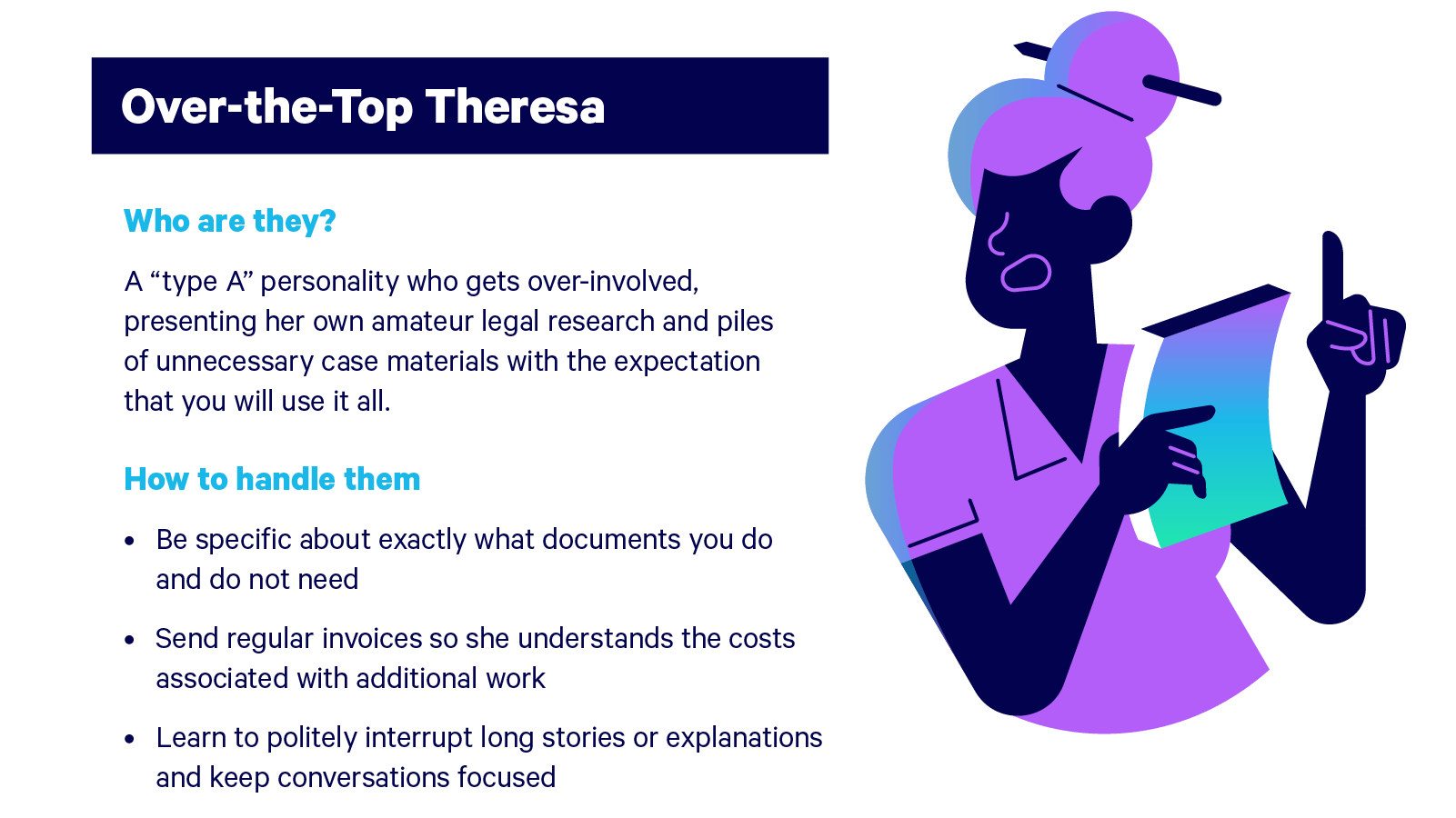
How to Handle Them
You’ll want to brush up on your boundary-setting skills as soon as an Over-the-Top Theresa walks through your door. To keep this client from overstepping, be prepared with strategies for keeping her at a polite professional distance.
1. Articulate What You Need (and What You Don’t)
Theresa operates on the assumption that more is always better, so it’s wise to place limits on what you need from her. Articulate your requests in “this, but not that” phrasing—for example, if you need a list of people involved in a situation, state explicitly that you want the list to include those who are directly involved and no one else. Explain that including extra information will make it more difficult for you to sort through what you do and don’t need, which takes valuable time away from the work of preparing your case.
2. Explain Your Billing Policy in Detail
Make sure Over-the-Top Theresa understands that, when she brings a stack of documentation that’s twice what you asked for, it’s going to take you twice as long to read it all, which means she’s going to be billed for twice as much time. If you gave her a cost estimate for the project or case overall, you may also want to point out that it was calculated based on average clients and cases. If she continues to provide unnecessary information or her meetings and communications are consistently overlong, she should be prepared for her case to cost much more than what you originally discussed.
3. Get Comfortable with Conflict
Over-the-top types are used to running people over, so you shouldn’t be surprised if you set boundaries with this client and they go unheeded. Be prepared to reiterate and reinforce your boundaries regularly, even if it’s a bit uncomfortable. If you’re dealing with a particularly persistent Over-the-Top Theresa, you may need to interrupt unnecessary explanations or stories in order to keep your client on task. Aim to strike a balance between being friendly and firm in order to retain control over your client interactions without being rude.
Difficult Client #3: Dishonest Dan
If a client feels nervous or guilty about aspects of their involvement in a situation, they may be tempted to fudge details or leave out information that they think will work against them. Alternatively, they may be making incorrect assumptions about the legal process based on others’ experiences or cases they’ve heard about in the news. For whatever reason, these Dishonest Dans aren’t completely truthful, and it’s going to interfere with your ability to work on their case.

How to Handle Them
The majority of Dishonest Dans aren’t devious people; more often than not, their deceptive behavior stems from misconceptions about the legal process that you can clear up easily at the beginning of your working relationship. If you do come across a client who’s committed to being untruthful, then you’ll need to evaluate whether you want to keep them on as a client.
1. Set Them At Ease
If a client is used to watching high-pressure legal dramas on TV, they may be gearing up for a similarly nerve wracking, emotional process. Take time to explain how the actual legal process works, being sure to highlight how it differs from the more stressful and dramatic picture they may have in their head. If your client does need to tackle a challenging witness testimony, walking them through what to expect or even arranging mock courtroom scenarios can help your client handle their anxieties.
If your client’s dishonesty seems to stem from a fear of retaliation by another party in the case, take the time to explain the terms of your attorney-client privilege. Reassure your client that the information they reveal to you will remain confidential save for certain circumstances where you might be considered a mandated reporter.
2. Ask for Transparency
In movies and television, criminal defense attorneys often want their clients to avoid telling them if they’re guilty of a crime. Your client may have made the assumption that this is the case in real life, too—even if theirs is a non-criminal case. In your first meeting with your client, explain to them that you do want, and in fact need them to tell you the truth without omissions in order for you to effectively argue their case. Offer to answer any questions they may have about the legal process and debunk any misconceptions they may have brought from their knowledge of fictional legal proceedings.
3. Clarify the Consequences
Once you’ve set the expectation that your client will be truthful with you, explain what will happen if they’re not—both in terms of natural consequences and with regards to your professional contract. Explain how working without all the facts can make it difficult for you to do your job and may harm your client’s case. Emphasize that it is in your client’s best interest to be honest with you.
Should you get the sense that your client remains untrustworthy, articulate to them that dishonesty will result in you terminating their contract. Include this information in the contract paperwork as well so that you have a written acknowledgement from your client that their honesty is a condition of your retainer.
Difficult Client #4: Loose Cannon Claire
There’s nothing more frustrating than establishing a strategy with a client, believing you’re on the same page, and then finding out later that they did the thing that you both expressly agreed they wouldn’t do. These clients, who agree to certain conditions while they’re in your office and then act in opposition to it as soon as they leave the room, are called Loose Cannon Claires.
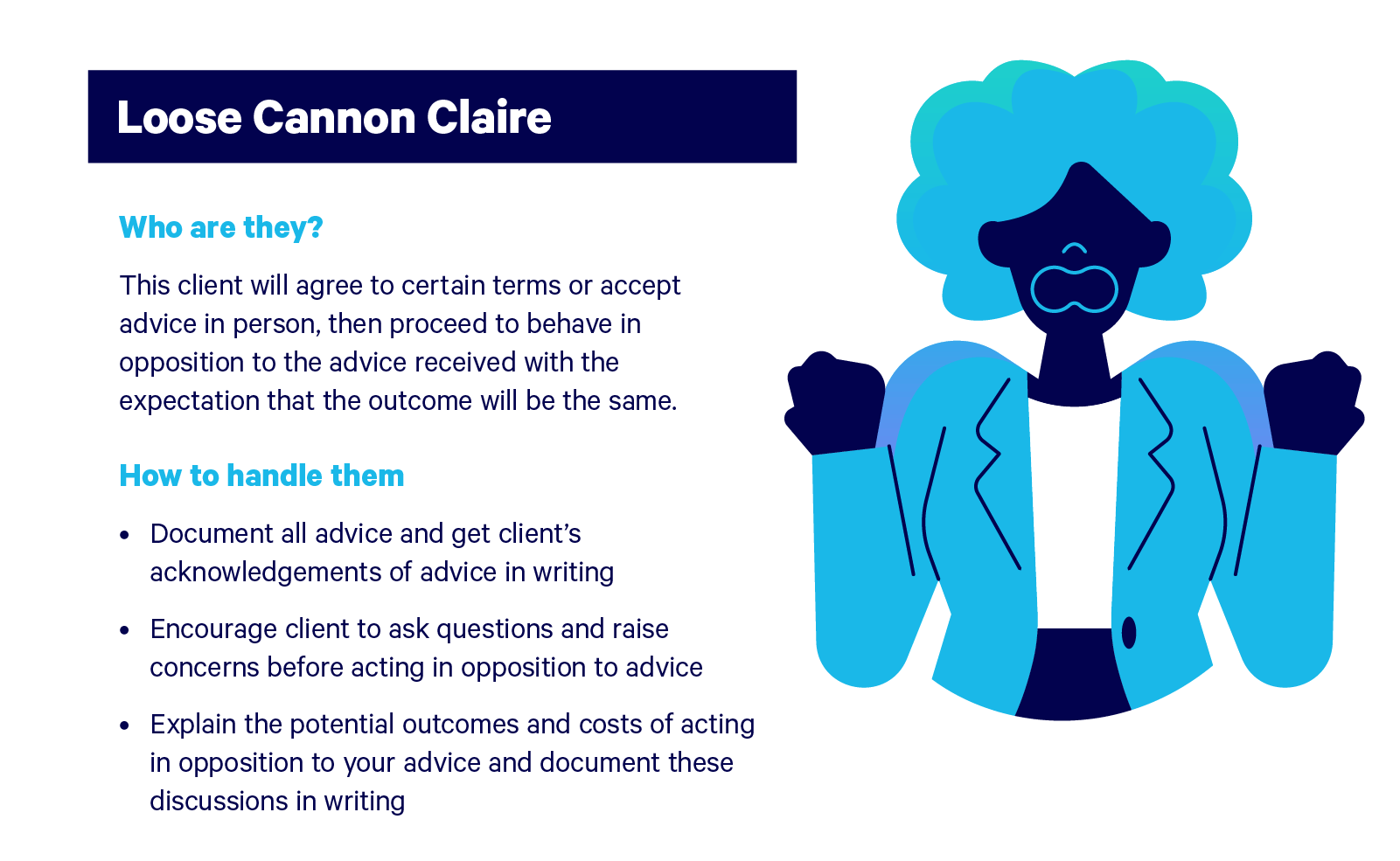
How to Handle Them
It’s always important to get things in writing when you’re working on a case, but documentation is doubly important when you’re dealing with a Loose Cannon Claire. It’s easier to keep clients accountable if you can confront them with proof of their past agreements, and having a paper trail will protect you against potential malpractice suits if your client decides to try to claim that they were acting upon your advice.
1. Document Your Conversations
It’s not enough to get your contract and agreements in writing. Loose cannon clients tend to say one thing and do another, so it’s important to keep a record of what you discuss in conversation so that you can review it together later after your client has behaved in opposition to what you discussed. You can even review your notes with your client and have them provide a signed acknowledgement of what you discussed in each meeting. Letting your client know that you’re keeping a detailed paper record will often discourage them from acting out in the future.
2. Encourage Questions
Sometimes your client will make a decision without understanding that it contradicts the advice you gave them previously. As you’re discussing the matter afterward, make sure you mention that your client can always ask for clarification or bring up specific scenarios if they’re unsure what the best course of action will be. For example, if you’re representing someone in a particularly acrimonious divorce, you’ll likely advise them to avoid discussing the case with their spouse. However, if your client is living or co-parenting with their spouse, they may not know how to avoid these conversations. Before you conclude your meeting, ask your client if they anticipate having any difficulties adhering to the advice you discussed so you can talk through strategies for avoiding trouble.
3. Explain the Consequences
If your client consistently behaves in ways that contradict your legal advice, it’s going to impact their case. The consequences can range from slight to dire. At a minimum, your client is going to make the case harder for you to win. More severe problems like parole violations or arrests can invalidate your arguments or take plea agreements off the table. Explain these potential outcomes to your client, and get their acknowledgement in writing. If they decide to continue their inadvisable behavior, you’ll have a record that shows you did your due diligence to warn them against it.
Difficult Client #5: Erratic Emily
Whereas Loose Cannon Claire’s unpredictable behavior takes place outside the office, Erratic Emily’s unreliable demeanor is clear during your interactions. She may forget key details, lose track of her testimony, or change her mind without warning. Typically caused by the stress of an emotionally trying case or some other type of unstable life situation, Erratic Emily’s behavior may not be her fault, but it can still interfere with your ability represent her.
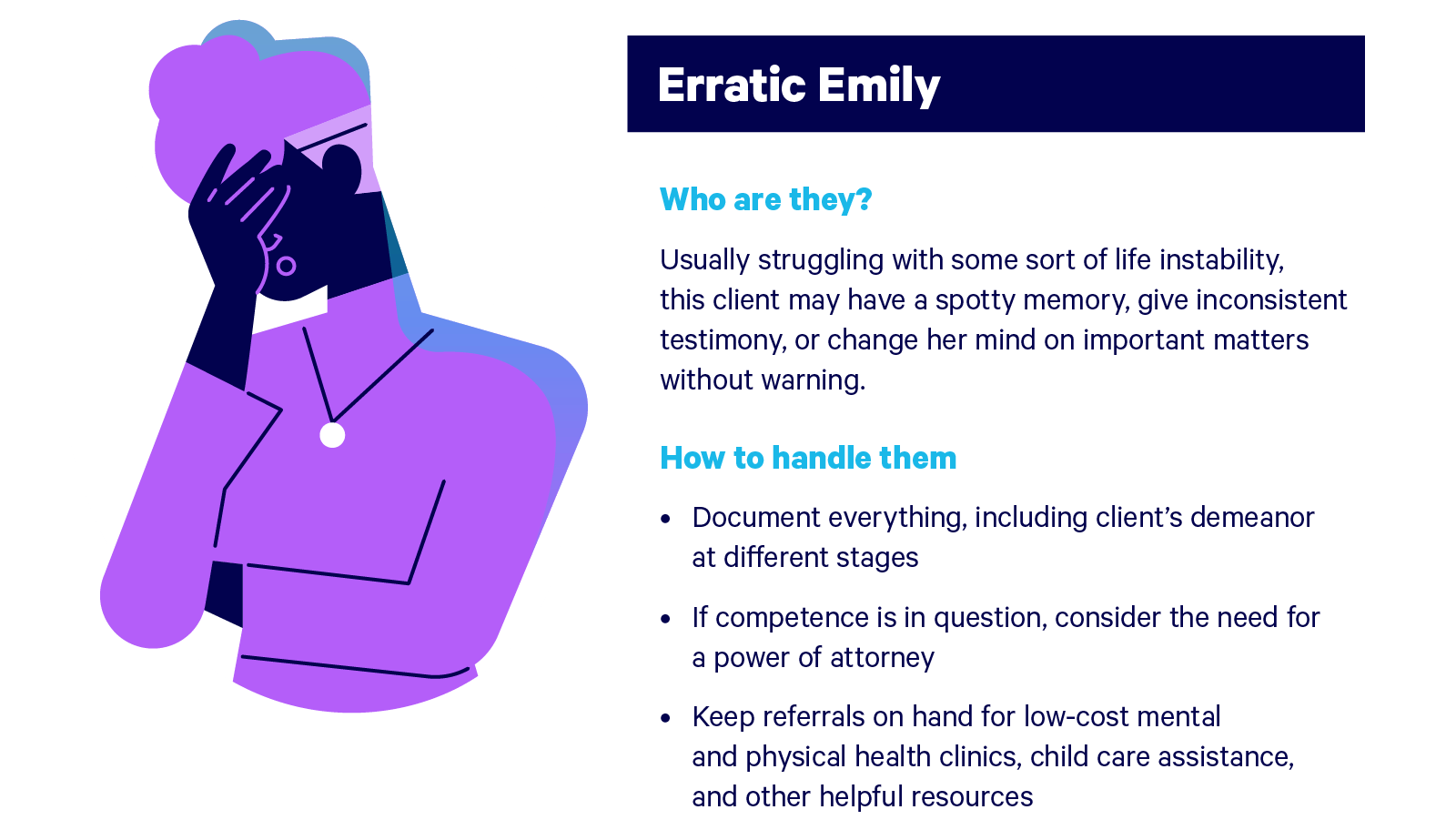
How to Handle Them
Your strategy with this client will be similar to the strategy used for Loose Cannon Claire: document, document, document. Keeping a clear record of your conversations and interactions can help your client keep things straight and will make things easier if you need to get a power of attorney involved to act on your client’s behalf.
1. Share Your Organizational Skills
Erratic Emily’s may simply be caused by the fact that she’s overwhelmed. A parent who’s trying to navigate a divorce while working full-time and continuing to get their kids to school, sports practices, and scout meetings is likely to forget things, but the situation isn’t so dire that their competency needs to be called into question. Forwarding your meeting notes, automating payments and meeting reminders, and extending any other administrative support possible will help your client regain a sense of control.
2. Document Everything
Maintaining copious notes can help your client keep track of what’s going on in their case, but it can also provide a safety net in case your client’s behavior grows so erratic that you need to consider outside intervention. In addition to documenting the talking points of your meetings, you should also note any extreme changes in behavior that could signal a more significant mental health issue is at play. Intense spikes in anger, uncontrollable crying, manic speech patterns, or signs of drug use should all be recorded.
3. Consider a Power of Attorney
If your client’s behavior becomes so unpredictable that you can’t reasonably work with them, you may want to consider suggesting that the client assign someone a power of attorney to act on their behalf. This will take at least some of the burden of legal basics off of your client’s shoulders, which should in turn alleviate some of their stress and allow them to return to some semblance of reliability and control. In an extreme circumstance where your client is incapable of making decisions independently, it may be appropriate to suggest the appointment of a conservator.
Difficult Client #6: Spineless Steve
As a lawyer, your job is to offer legal advice. What some clients don’t necessarily understand is that legal advice is usually very open-ended, which means that they will still have many decisions to make on their own. Decision-making is a weakness for Spineless Steve, so he’ll do just about anything to get you to make his choices for him. While it may be tempting to just go ahead and give him the advice he wants, this is a dangerous path to tread—should Steve’s case not turn out the way he had hoped, he’ll look to you to take the blame.
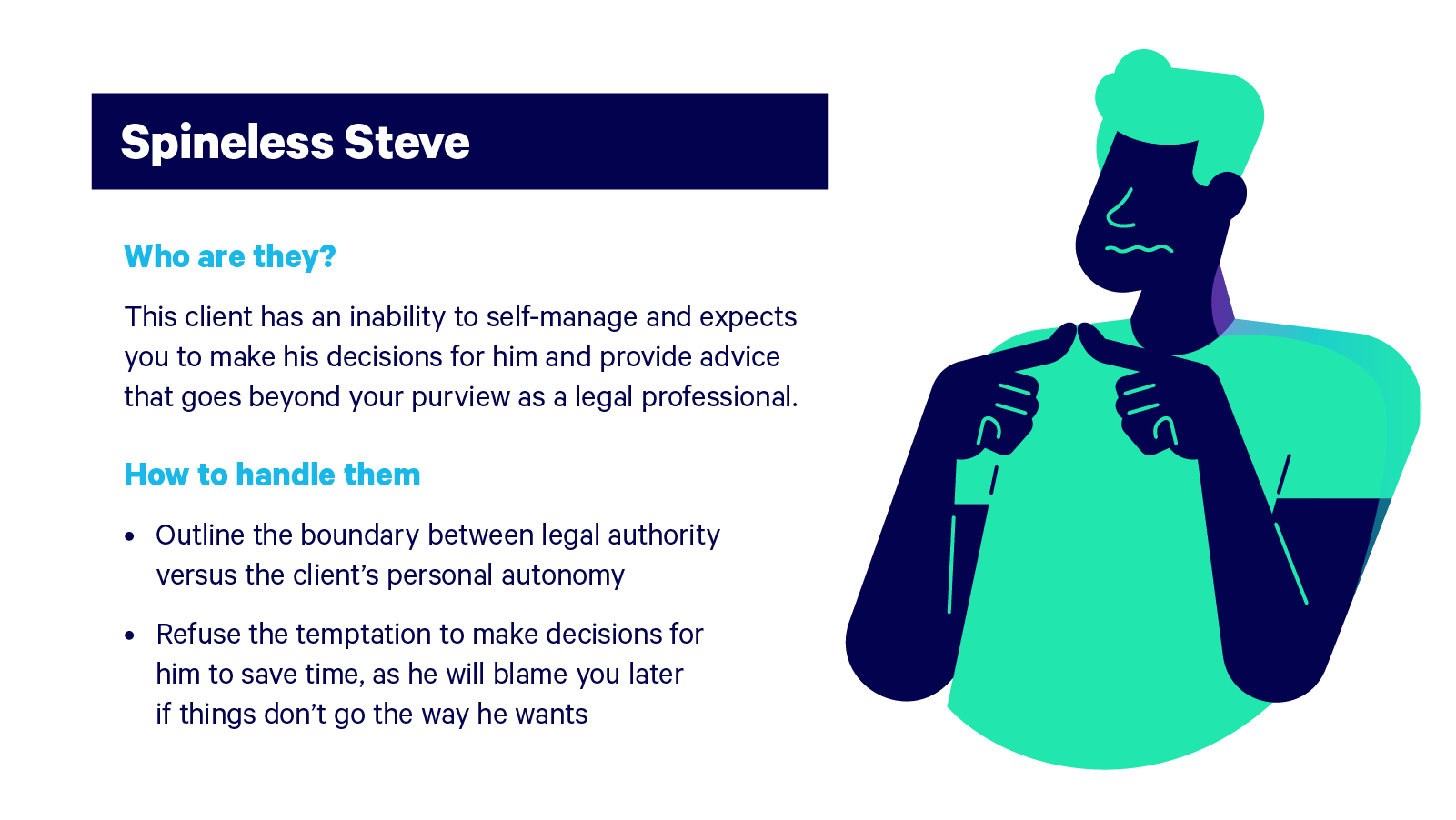
How to Handle Them
Spineless Steve is looking for an authority figure in his life to make his decisions for him in an effort to avoid the consequences of a wrong decision. It’s imperative that you resist this client’s attempts to solicit your advice on anything outside the realm of your legal training—should things go wrong, Spineless Steve can become surprisingly aggressive in his expectation that you take responsibility for a negative outcome.
1. Draw Boundaries
As with so many difficult legal clients, the most powerful tools available to you are strong, well-defined boundaries. We may call him Spineless Steve, but in reality many of these clients can have large and charismatic personalities, making it even more difficult to avoid being coerced into answering their questions about non-legal decisions. Be prepared to rebuff repeated requests by reiterating what guidance you can and can’t give as Steve’s attorney, and if he’s unwilling to accept your terms, don’t hesitate to end the conversation or, if his behavior is persistent or inappropriate, the contract.
2. Explain the Difference Between Legal Advice and Life Counseling
Many Spineless Steves genuinely won’t understand the difference between what is legal advice and what isn’t. It’s worth taking the time to explain exactly what types of advice you can give and include examples of advice that you can’t offer.
Other Spineless Steves are less clueless—their main objective is to avoid ever being on the hook for the consequences of their own actions. When you’re dealing with these types of clients, don’t be afraid to say outright that the reason you won’t overstep is because you aren’t willing to be held liable for anything except the service you’re professionally trained to perform.
3. Recommend Alternative Resources
Just because you’re not willing to give your client life advice doesn’t mean that there aren’t professionals out there who offer this exact service. If your client is insistent that they need help making decisions that lie beyond the scope of your legal expertise, suggest that they consider hiring a counselor, therapist, or life coach to assist in guiding them through the issues that can’t be resolved with legal advice. If affordability is an issue, do some research to find low-income resources in your area that you can keep on hand.
Difficult Client #7: No-Show Nick
When you work on more sensitive cases that involve issues like divorce, domestic abuse, child abuse or neglect, and other similar situations, you’re more likely to work with clients who are struggling with serious personal or mental health issues. No-Show Nicks are clients whose lives have become so overwhelming that they can’t keep up with basics like returning calls, keeping appointments, and handling paperwork, making it difficult for you to work on their case.
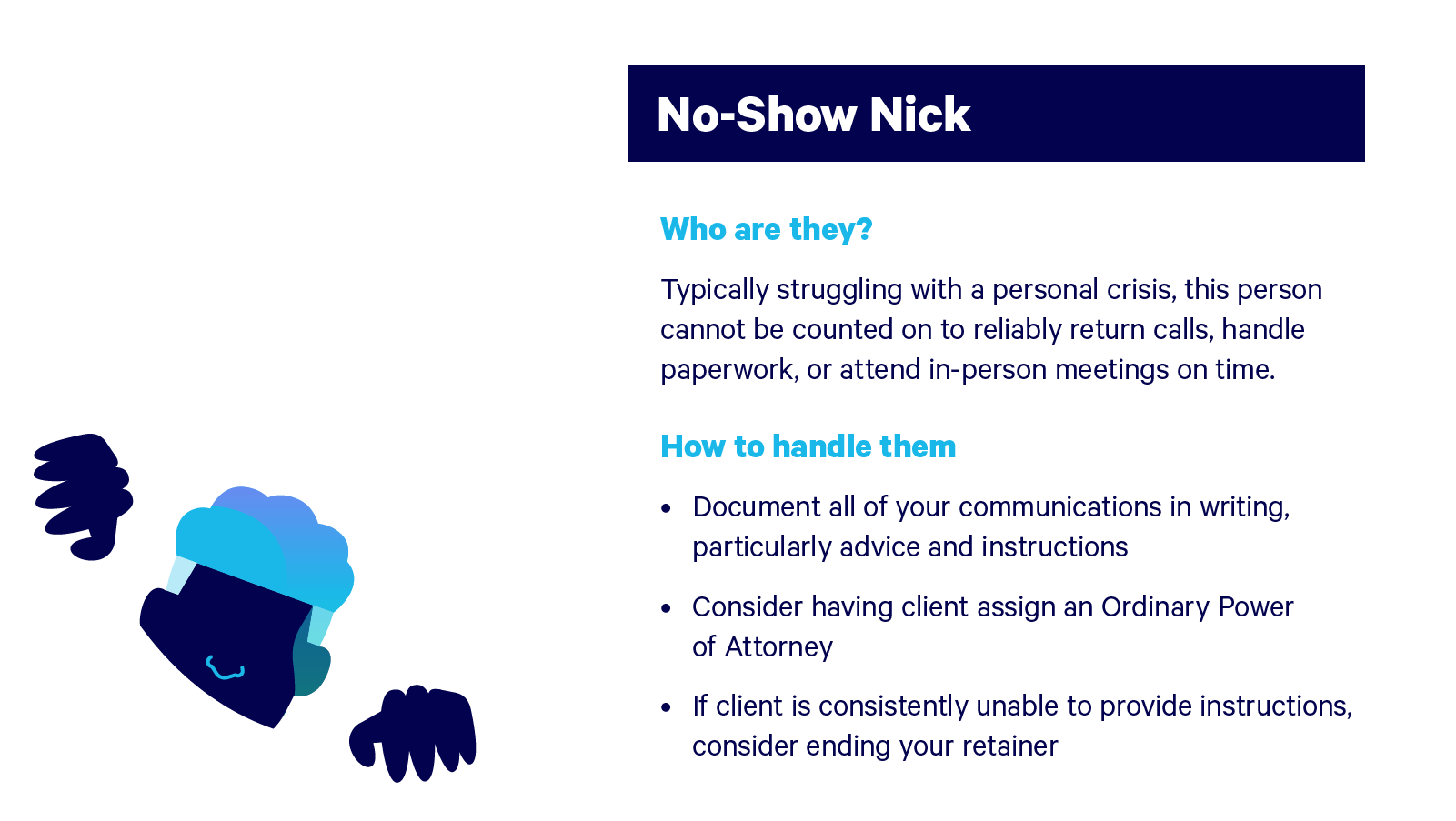
How to Handle Them
In this case, we’re discussing No-Show Nicks whose behavior is caused by some significant personal crisis, not by a lack of care or consideration on their part. If you sense that your client is simply rude or can’t be bothered to treat you and your staff with respect, you should give consideration to whether it’s worth continuing the professional relationship or not. But in cases where a client is struggling to keep their head above water, it’s better to lead with empathy and come up with a solution that addresses the underlying issue rather than immediately becoming frustrated with the client.
1. Document Everything
As is the case with any sort of unreliable client, your first move should be to keep detailed notes documenting all of your interactions with your client and to request frequent acknowledgements of what you discussed, which the client should sign in writing. Documenting your interactions will provide you with a paper trail that will be necessary later if the client needs to assign a power of attorney. Making your notes available to the client in a central location may also help them get a handle on their side of the situation.
2. Simplify Wherever Possible
Keep in mind that your client is dealing with information and emotion overload, which means their bandwidth for making decisions and solving problems is at a minimum. Whenever you need a decision from your client, try to pose it in the form of an “either/or” choice rather than an open-ended question. Researchers have shown that humans will resist making decisions when they have more options to choose from. With a client who’s already overwhelmed, you’ll get more done if you can simplify choices wherever possible.
3. Consider a Power of Attorney
If your client is simply struggling too much to reliably work with you on their case, discuss the possibility of assigning a power of attorney. Explain the benefits of involving someone else to act on your client’s behalf, and remind them that they will maintain the ability to make decisions on their own as well. Encourage them to view a power of attorney as a tool that will help them regain some control over their circumstances, and set them up with the necessary administrative support they’ll need to get power of attorney paperwork signed and filed.
Difficult Client #8: Two-Faced Tia
Occasionally, you may come across difficult clients without realizing it. Two-Faced Tia will be on her best behavior for you, knowing she needs your cooperation in order to get what she wants. But when she thinks you’re out of earshot, Tia is disrespectful or even abusive toward those she considers unimportant.

How to Handle Them
Much like Over-the-Top Theresa and Spineless Steve, Two-Faced Tia needs to be given clear, well-articulated boundaries. But unlike other clients, Two-Face Tia will also need to see right away that you have the backbone to enforce those boundaries, and that you won’t hesitate to end her contract if she decides to continue exhibiting inappropriate behavior.
1. Establish a Support System
First and foremost, you need to ensure your employees feel comfortable enough to come to you about inappropriate client behavior. Make sure your staff knows they can trust you to stand up for them, and that you’ll never ask them to put up with mistreatment by a client, coworker, manager, or anyone else.
Consider designating multiple staffers of different genders as “go-to” contacts for tricky or uncomfortable workplace problems.
2. Confront Your Client Quickly
Once you’ve been made aware of a client’s inappropriate behavior, you need to act immediately.
Everyone has bad days, and it’s okay to give clients the benefit of the doubt when it comes to foibles like the occasional peevish comment or bad attitude. But some behavior—shouting or swearing, physical intimidation, threats, accusations, etc.—is never acceptable for any reason, and it needs to be addressed right away to either correct the behavior or avoid prolonging your relationship with a problematic client.
3. Be Respectful, but Resolute
Find an opportunity to speak with your client privately, whether in person or over the phone. Keep your demeanor polite and professional and be prepared to maintain your calm demeanor regardless of whether your client becomes angry or upset.
Avoid inflammatory language, opting instead for neutral phrasing that offers few opportunities for your client to engage you in conversation or debate about the issue. Do not give your client any unnecessary details that they can use to deflect or derail the conversation. For example, compare the two approaches below:
Approach #1: “Dave put you on speakerphone when you called yesterday, so I heard you screaming your head off about your invoice. You have some serious anger management issues and you need to get them under control.”
Approach #2: “I was made aware of an incident yesterday in which you raised your voice and used inappropriate language with our billing department. That sort of behavior is not acceptable in this office, and if it happens again, your retainer agreement will be terminated immediately.”
The first approach uses subjective descriptions like “screaming your head off” and “serious anger management issues” that are more likely to provoke a reaction from the client, and it doesn’t provide clear-cut explanations of what consequences can be expected in case the behavior continues. The second approach, which uses neutral language and gives the client few opportunities to argue, is more effective.
Difficult Client #9: M.I.A. Michael
The legal equivalent of a dine-and-dasher, M.I.A. Michael is the perfect client until it’s time for him to pick up the tab. Once he’s gotten what he needs from you professionally, this client has no reason to answer phone calls, respond to emails, or send responses to your requests for payment. To avoid trouble down the line, you’ll want to make sure these clients are paying as they go (otherwise they’ll go before they pay!)
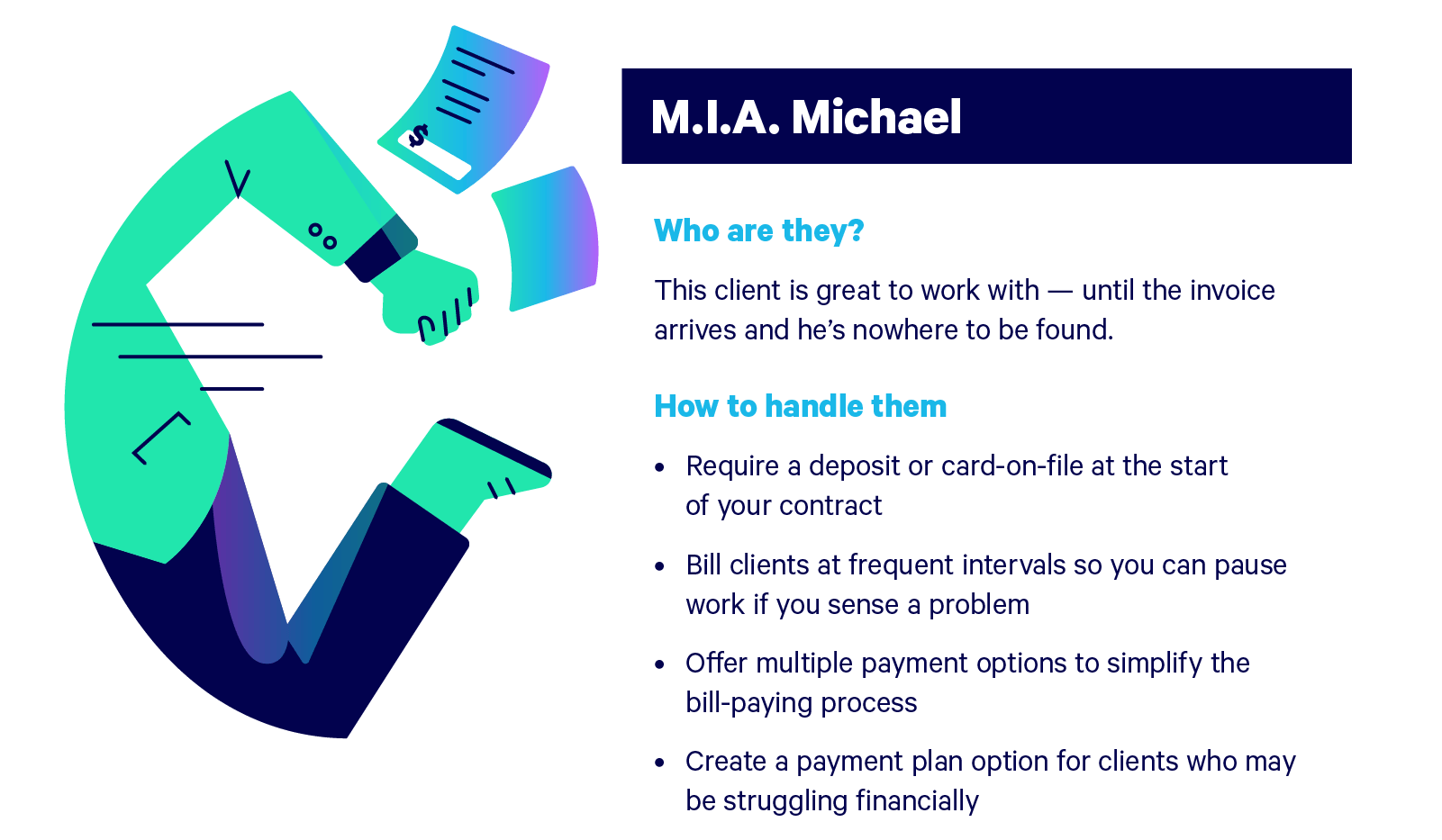
How to Handle Them
The key to avoiding a client vanishing act is to keep some leverage or collateral that makes it difficult for them to simply disappear on you. As long as you still have something that this client needs, they won’t be able to drop off the grid.
1. Put a Card On File
The easiest way to ensure that clients can’t avoid paying for services is to place a card on file at the beginning of your relationship. Include a clause in your contract that explains that you will charge the card on file for any outstanding payments after a certain period of time. You may also want to require a deposit, however, as you may find that M.I.A. Michael has pulled a vanishing act on his credit card provider as well.
2. Bill Clients Frequently
Paperwork is a pain, so it’s easy, especially for small or independent firms, to put off billing clients for services until the end of the contract or case. However, invoicing clients periodically throughout the working relationship will protect you from potential losses and make it easier to halt services if more multiple invoices have gone unpaid. If you’re collecting payments from your client all along, you’ll have much less to lose if they go M.I.A. on the final invoice and you have to write a debt collection letter.
3. Offer Payment Options and Repayment Plans
If you can make it easier for your client to pay their bills, you’ll have much more luck when it comes to collecting payments. In addition to the basics like cash, credit, and checks paid in person, you should also set up online and over-the-phone payments. Many people prefer to set up autopay so they don’t have to remember to submit payments on a particular date.
For clients who are having trouble paying their bills, consider offering repayment plan options that allow clients to send smaller payments over a longer period of time, often with a small interest rate. Make it clear to your clients up front that you’re willing to work with them to find a solution that works for you both.
No matter what type of difficult clients you encounter, legal malpractice insurance is a must to protect your law firm against claims and accusations from unhappy customers. Though complaints made by difficult clients are often illegitimate, the reality is that everyone makes mistakes. Malpractice insurance will cover you in case of legitimate errors and omissions, so you’re protected even if a client’s complaint turns out to be true. With the confidence of knowing you’re covered, you can save your energy for handling difficult clients, winning difficult cases, and attracting new clients.

Related Articles
The Ultimate Guide: How to Grow a Law Firm
19 min readReady to expand your business, but not sure where to start? We’ve assembled an all-inclusive manual on how to grow a law firm.
20 Best (and Worst) U.S. Cities for Lawyers
13 min readUsing our data, we put together lists of the 20 best and worst cities for lawyers to give you a better idea of how legal industries vary across the country.

